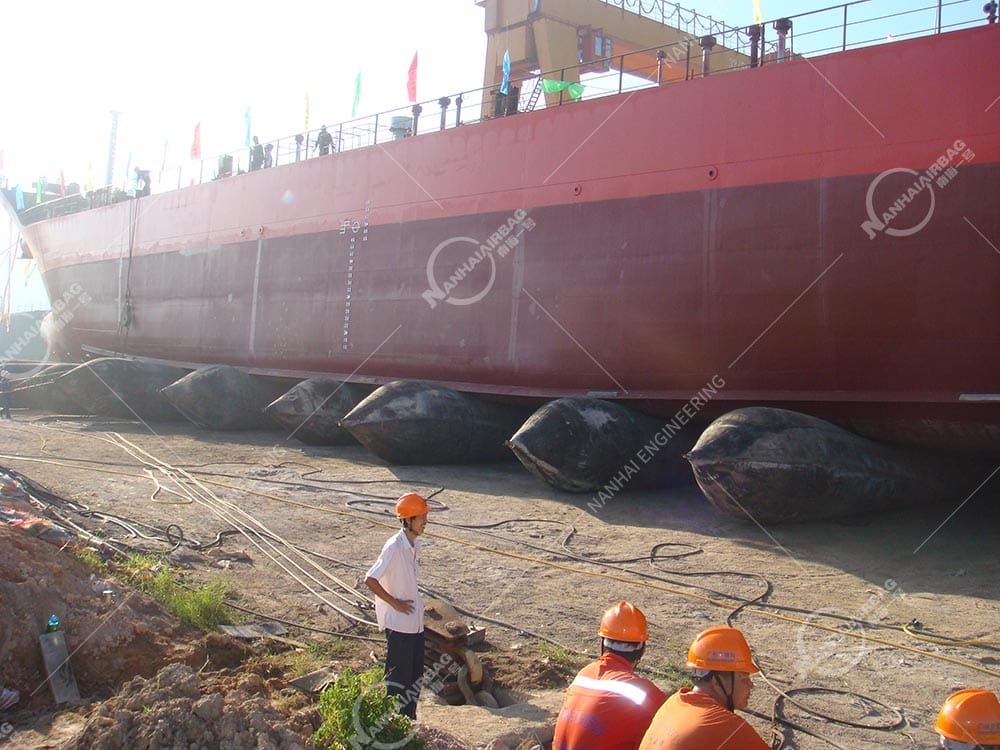Руководство по обслуживанию судовых подушек безопасности
11/25/2024Сценарии применения морских подушек безопасности
11/27/2024Как правильно использовать морские подушки безопасности

Correct use of marine airbags is essential for ensuring the safe operation of ships and improving efficiency. People primarily use запуск подушек безопасности для корабля to support buoyancy, raise sunken ships, repair vessels, and load or unload cargo.. Below are some steps and precautions for correctly using marine airbags:
1. Preparation
- Inspect the Airbags: Before use, first inspect the marine airbags for visible damage such as cracks or other defects. If any issues are found, the airbag should be repaired or replaced.
- Ensure Inflating Equipment is Functional: Check the inflating equipment (such as air pumps or compressors) to ensure it is functioning properly and that the inflation interfaces are compatible with the marine airbag to avoid leaks.
- Choose the Appropriate Airbag Specifications: Select the correct airbag size and specifications based on the ship’s size, weight, buoyancy requirements, and the specific tasks at hand. Ensure the airbag’s buoyancy and load capacity meet the actual needs.
2. Installing the Airbags
- Determine Installation Location: Based on the ship’s design and operational requirements, choose the appropriate location for the airbags. Typically, airbags should be placed at the bottom of the vessel or in areas that require additional buoyancy.
- Ensure Stable Contact: When installing the airbags, make sure you position them securely against the ship’s hull to prevent punctures or excessive rubbing from sharp objects.
- Secure the Airbags: Secure the airbags with ropes, hooks, or other devices to prevent them from moving or detaching during inflation or operation.
3. Inflation Process
- Check Inflation Equipment: Ensure that the inflation equipment is in good condition, and that pressure gauges and other monitoring devices are working properly.
- Inflate Gradually: Begin inflation gradually without rapid pressure increases. During inflation, monitor the airbag’s shape closely to ensure it does not overinflate or crack.
- Control the Pressure: Inflate the airbag according to the recommended pressure range provided in the manual. Over-inflating can cause the airbag to burst or deform, while under-inflating will reduce its buoyancy and load capacity.
- Inflate Evenly: If using multiple airbags, ensure that all airbags are inflated evenly to avoid localized over-pressurization or insufficient inflation.
4. Operational Precautions
- Monitor Airbag Condition: Continuously monitor the marine airbags’ pressure, condition, and buoyancy during operation. Regularly check the surface for wear or cracks.
- Избегайте перегрузок: Ensure that the airbags’ load capacity is not exceeded. Overloading can lead to airbag damage or failure.
- Prevent Contact with Sharp Objects: During repairs or lifting operations, avoid letting the airbags come into contact with sharp objects or hard surfaces to prevent punctures.
5. Deflation Process
- Deflate Gradually: After completing the operation, deflate the airbags gradually. Rapid deflation can cause damage to the airbags.
- Safe Deflation: Ensure that the deflation valve and connection parts are intact to prevent leakage. When deflating, maintain the airbag’s stability and avoid sudden deflation that could damage it.
- Inspect the Airbags: After deflation, inspect the airbags for damage or wear to ensure they are in good condition for the next use.
6. Storage and Maintenance
- Clean the Airbags: After use, clean the airbags promptly to remove saltwater, dirt, and other contaminants, which helps extend their service life. Avoid using strong acids, bases, or solvents for cleaning.
- Storage Conditions: Store the airbags in a dry, cool place away from direct sunlight. Protect them from high temperatures, humidity, chemical exposure, and physical damage.
- Регулярные проверки: Even when not in use, periodically check the airbags to ensure they remain in good condition, especially after being stored for an extended period.
7. Emergency Handling
- Minor Damage Repair: If small cracks or damage are found, immediately repair the airbag with specialized repair materials. After repairs, recheck the air pressure to ensure the airbag is functional.
- Airbag Failure Response: If an airbag fails during operation and cannot be restored, cease operations immediately and use backup airbags. Contact professional personnel for further handling.
